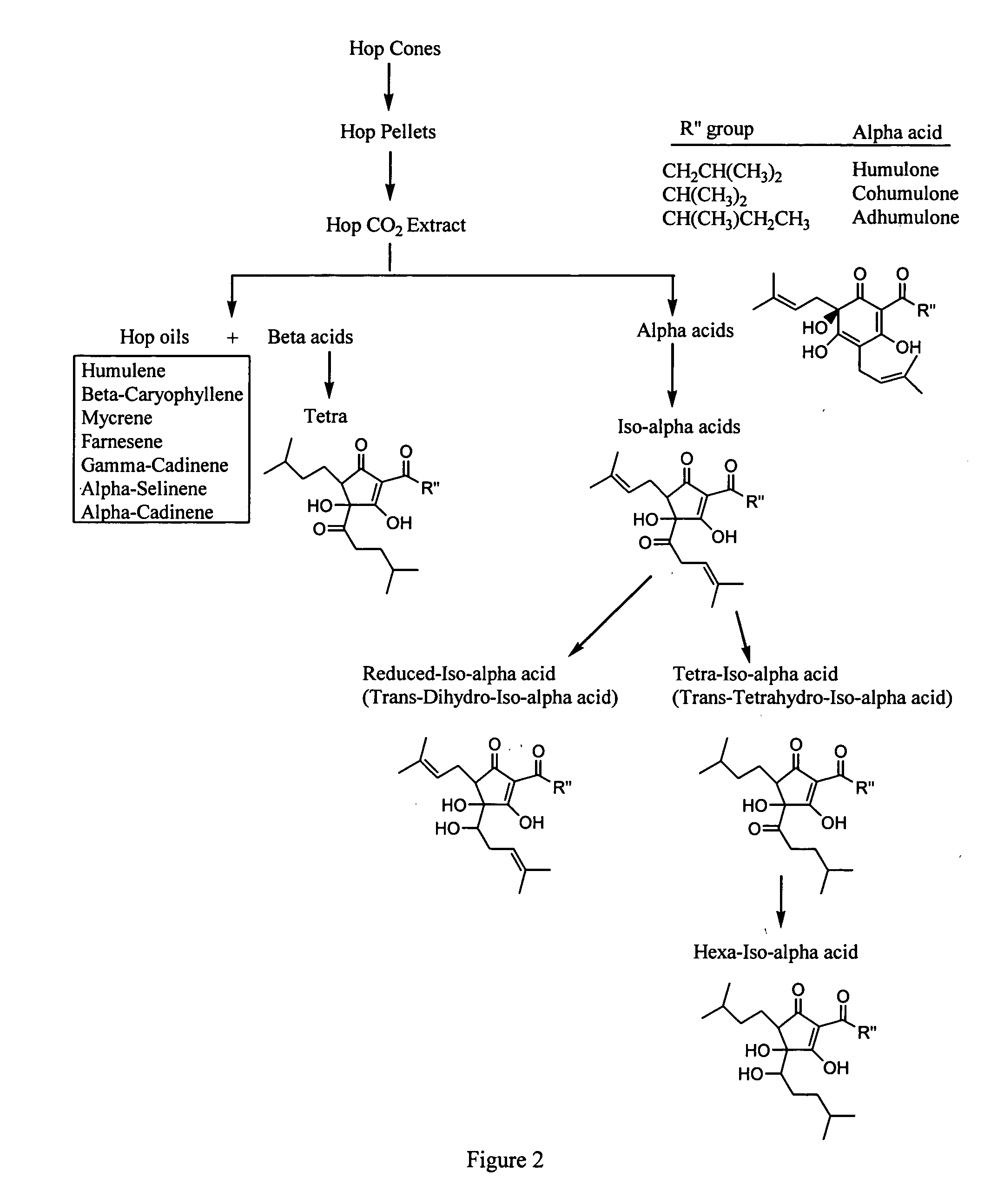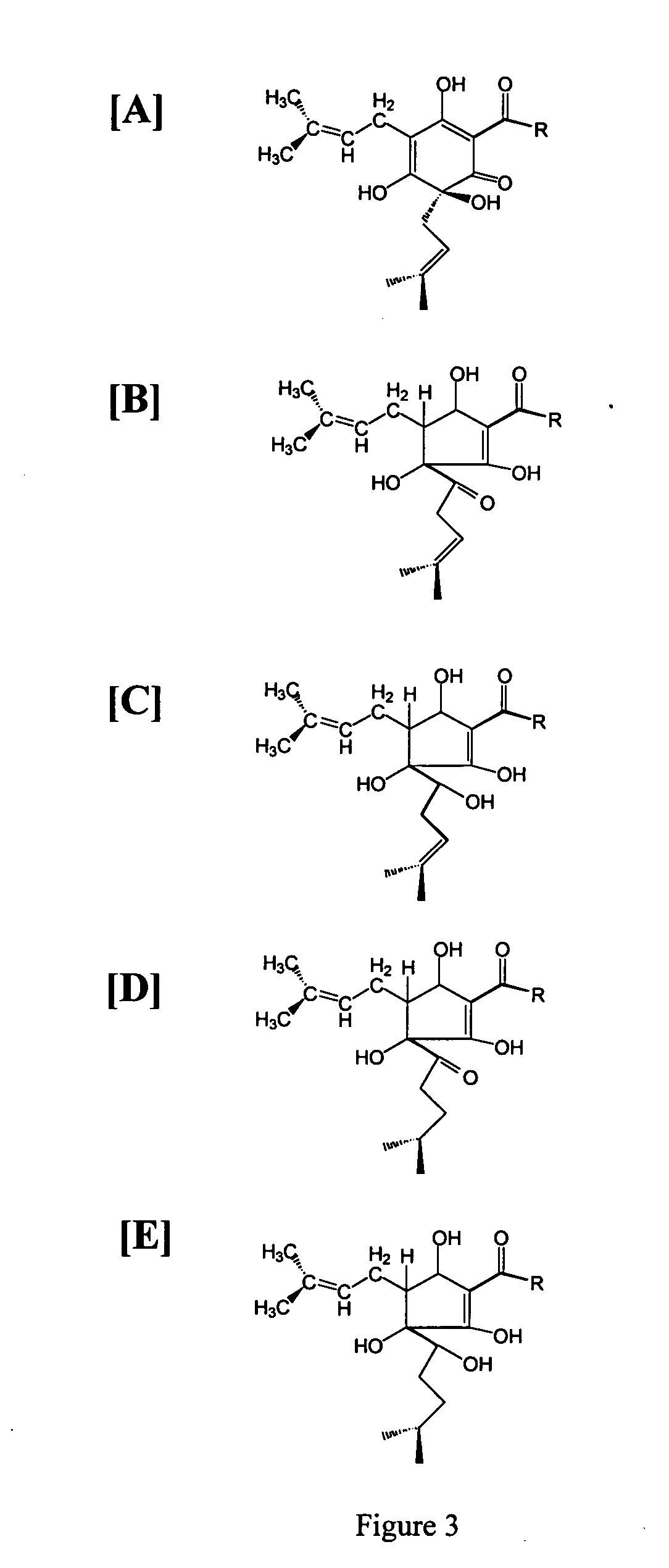Synergistic anti-inflammatory pharmaceutical compositions and methods of use
a technology of pharmaceutical compositions and compositions, applied in the field of pharmaceutical compositions, can solve the problems of inability to achieve the ideal assay for cox-2 selectivity, differences in assay methodology can have profound effects on the results obtained, and inability to replicate biological responses, etc., to achieve the effect of reducing inflammation
- Summary
- Abstract
- Description
- Claims
- Application Information
AI Technical Summary
Benefits of technology
Problems solved by technology
Method used
Image
Examples
example 1
Inhibition of PGE2 Synthesis in Stimulated and Nonstimulated Murine Macrophages by Hops (Humulus lupulus) Compounds and Deriatives
[0088] Summary—This example illustrates that hops fractions and derivatives inhibit COX-2 synthesis of PGE2 preferentially over COX-1 synthesis of PGE2 in the RAW 264.7 murine macrophage model.
[0089] Chemicals and reagents—Bacterial lipopolysaccharide (LPS; B E. coli 055:B5) was from Sigma (St. Louis, Mo.). Hops fractions (1) alpha hop (1% alpha acids; AA), (2) aromahop OE (10% beta acids and 2% isomerized alpha acids, (3) isohop (isomerized alpha acids; IAA), (4) beta acid solution (beta acids BA), (5) hexahop gold (hexahydro isomerized alpha acids; HHIAA), (6) redihop (reduced isomerized-alpha acids; RLIA), (7) tetrahop (tetrahydro-iso-alpha acids THIAA) and (8) spent hops were obtained from Betatech Hops Products (Washington, D.C., U.S.A.). The spent hops were extracted two times with equal volumes of absolute ethanol. The ethanol was removed by heat...
example 2
Lack of Inhibition of PGE2 Synthesis in Gastric Mucosal Cells by Hops (Humulus lupulus) Compounds and Derivatives
[0102] Summary—This example illustrates the lack of PGE2 inhibition by hops fractions and in the AGS human gastric mucosal cell line implying low gastric irritancy potential of these compounds.
[0103] Chemicals and reagents were used as described in EXAMPLE 1. PGE2 was determined and reported as previously described in EXAMPLE 1. The median inhibitory concentrations (IC50) for PGE2 synthesis from AGS cells were calculated as described in EXAMPLE 1[2].
[0104] The human gastric mucosal cell line AGS was obtained from the American Type Culture Collection (ATCC number CRL-1739; Manassas, Va.) and sub-cultured according to the instructions of the supplier. The cells were routinely cultured at 37° C. with 5% CO2 in RPMI 1640 containing 10% FBS, with 50 units penicillin / mL, 50 μg streptomycin / mL, 5% sodium pyruvate, and 5% L-glutamine. Exponentially growing cells were seeded in...
example 3
Acute Toxicity of Genus A and Genus B Hops Derivates in Rats
[0106] The acute toxicity of hops derivatives is examined in rats. Ten, young, Fisher 344 male rats averaging 100 g are orally dosed with 5000 mg test material / kg body weight and observed for 14 days; the number of dead rats is determined. The low acute toxicity of hops derivatives is illustrated by lack of lethality when administered to rats orally at 5,000 mg test material / kg body weight.
PUM
| Property | Measurement | Unit |
|---|---|---|
| Ratio | aaaaa | aaaaa |
Abstract
Description
Claims
Application Information
 Login to View More
Login to View More - R&D
- Intellectual Property
- Life Sciences
- Materials
- Tech Scout
- Unparalleled Data Quality
- Higher Quality Content
- 60% Fewer Hallucinations
Browse by: Latest US Patents, China's latest patents, Technical Efficacy Thesaurus, Application Domain, Technology Topic, Popular Technical Reports.
© 2025 PatSnap. All rights reserved.Legal|Privacy policy|Modern Slavery Act Transparency Statement|Sitemap|About US| Contact US: help@patsnap.com



